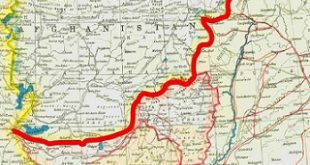Foreign-Drawn, Ethnically Biased, Artificial Demarcations
The ‘Durand Line’ originally posed as a ‘line separating or demarcating ‘spheres of influence’ between British India and Czarist Russia during the 19th century, has evolved as an international boundary and ongoing fodder for endless and contentious debate.
This colonial-era insult was invoked to separate and weaken and thereby control and shape Afghanistan’s majority…the Pashtuns to British-India’s colonial influences and interests.
Established in 1893, Afghanistan’s position and that of a majority of legal scholars is that Pakistan has no legal right and or precedent to be as inheritor to the assets of British India…A position long-taken by most legal and recognized international scholars. Apparently unbeknownst to indifferent American diplomats and policy makers, the Durand Line spanning 2640 kilometers (1,640 miles) boasts a long and porous border with Pakistan, and has long been a contentious-issue for many Afghans who believe that Pakistan’s Federally Administered Tribal Agency (FATA) have in effect seized a sizeable portion of land that belongs to them.
While America has long held itself out as a proponent for democracy and the rule of law for more than 200-years, it’s therefore a shame that their largely illegal, covert ‘War on Terror’ guise marks a sharp departure from both. Mark Grossman, Special Representative for Afghanistan/Pakistan said recently (Global Research, 04/21) that ‘our (US) policy is that the border is the international border.’ With what has been termed a 120-year old insult and affront to Afghanistan’s national integrity and sovereignty, the Durand Line has thus evolved as a divisive tool and tactic for international gerrymandering.
Separating the Afghan/Pakistan community through diplomatic maneuvering has long been a tactic of Western and Slavic powers for centuries. A divided nation…so goes the theory…is a weakened nation. During the Cold War, the USSR engaged in a plot to divide Afghanistan, (Operations Kaskad and Chameleon) plots whereby the northern reaches of the country would be seized and incorporated into what was termed a ‘Greater Tajikistan’. In this regard, the Soviets employed the late Ahmad Shah Massoud to work towards this eventuality, and with promise of a leadership position, Shah Massoud acquiesced to Moscow’s plan for the duration of the war. Again, as with Colonial Britain, the Soviet plan to partition was developed to weaken the Afghan Resistance and to incorporate the resource-rich northern environs into the Soviet orbit as well.
The Afghan daily Weesa quoted several Afghan law makers describing the obviously biased US statement in regards the historically-recognized and accepted latitudinal and longitudinal position of the AF/PAK border, as ‘interference in domestic Afghan affairs.’ The Afghan Foreign Ministry declared that ‘the status of the Durand Line was a matter of historic proportion for the people of Afghanistan.’ The Line runs through traditional Pashtun lands, splitting one of the world’s largest tribal societies into two geographic entities.
A majority of Afghans still dream of a return to a much more vast and united Afghanistan that existed prior to the advent of European colonialism in South Asia. After losing a major war to the Afghans in 1842, the British eventually captured and occupied parts of Afghanistan and formally annexed them through an arbitrary treaty in 1879. The contentious 1893 treaty between Afghan King Amir Abdur Rahman (Iron Amir) and Mortimer Durand, the Foreign Secretary of British India formalized the area under control of two (Afghan and British India) governments.
That the agreement was signed under duress is but one point or bone of contention. Even Sir Mortimer Durand recognized the illegality and impropriety of the treaty which did not recognize the validity and or annexation of the infamous treaty.
During the 19th century the Russians seized sizeable amounts of Afghan land in the Panjdeh region in northern Afghanistan. At that time, British India likewise seized through diplomatic legerdemain portions of traditional Pashtun lands with the imposition of an unsanctioned, illegal and unwarranted demarcation. Today, under the ruse of fighting the ‘War on Terror’ and reinforced by and under US diplomatic gerrymandering, the largest tribal confluence in the entire world is in mortal danger of permanent dislocation through the subversive, delineation of an arbitrary line on a map. The drastic severance of familial bonds and centuries-old traditional land holdings through diplomatic legerdemain between a super power and their area proxy… constitutes a war crime and cannot therefore be tolerated.
The Afghan people are duty-bound to protect their traditional culture and treasured lands from imperial encroachment. Borders as with sovereignty are inviolable. The US position, policies reflective of a baseless and demonstrably-illegal war, and in political lock-step with 19th century colonialism and imperialist policies that along with their Pakistan proxies land grab initiatives … cannot be allowed to stand…this is an absolute and sovereign imperative for all freedom-loving Afghans and those who hold international law as sacrosanct.
Bruce G. Richardson
Notes:
For additional reading on the controversial, contentious Durand Line, See: (Afghanistan, Political Frailty and External Interference, Dr. Nabi Misdaq, 2006, pp. 24, 60-61, 69-70, 76-77, 227, 293-299, and Afghanistan, A Search for Truth, Bruce G. Richardson, 2009, pp. 59-62, 62-72)
 لراوبر ویب پاڼه لراوبر يو افغان – تازه خبرونه
لراوبر ویب پاڼه لراوبر يو افغان – تازه خبرونه


